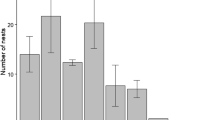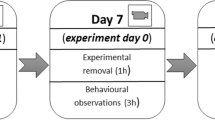Summary
To determine the effects of male mating status on female fitness, we compared the reproductive success, survival, and future fecundity of female Savannah sparrows (Passerculus sandwichensis) mated to monogamous vs. polygynous males in a 5-year study on Kent Island, New Brunswick, Canada. The proportion of males with more than one mate varied from 15 to 43% between years and sites. Polygynous and monogamous males fledged young of equal size in every year of the study. Females who shared paternal care with other females laid as many eggs per clutch and clutches per season as monogamously mated females. In most years polygynously mated females showed no delay in laying a second clutch, and they suffered no reduction in fecundity the following year. Recruitment of a female's offspring into the breeding population was generally independent of her mating status. Fitness costs of being mated to a polygynous male were only apparent in one year of the study, during which females mated to polygynous males had higher over-winter mortality than those mated to monogamous males. That same year, young raised by polygynous males were only one-third as likely to survive to reproductive maturity (as inferred by returns) as those raised by monogamous males. A male's mating status had no effect on his own survivorship. A male's mating status did not necessarily reflect his contributions to raising nestlings, which may partially explain why monogamously and polygynously mated females had equal fitness. At 35 nests the proportion of food deliveries brought by individual males varied from 0 to 75%; on average, males brought fewer than 30% of all food deliveries. Yet parental care by polygynous males was no less than that of monogamous males, at least at the nests of their primary females. Secondary females tended to receive less male assistance during the nestling stage, but their reproductive success was indistinguishable from that of primary females. Females feeding young without male assistance made as many food deliveries/h as did pairs in which males brought at least 30% of all food deliveries. Unassisted females did not suffer diminished fledging success or produce smaller fledglings. The benefits of polygyny for male Savannah sparrows are clear: polygynous males recruit more surviving offspring into the breeding population than monogamous males. The fitness of females, on the other hand, appears to be unaffected by whether their mate was monogamous or polygynous except in occasional years. Polygyny may be maintained in this population by the constraints of a female-biased sex ratio, the inability of females to predict a male's paternal care based on his morphology or behavior, the poor correlation between a male's mating status and his assistance at the nest, and inconsistent natural selection against mating with a polygynous male.
Similar content being viewed by others
References
Abacus Concepts (1988) Statview SE + Graphics. Abacus Concepts Inc, Berkeley, California
Alatalo RV, Lundberg A, Ståhlbrandt K (1982) Why do pied flycatcher females mate with already-mated males? Anim Behav 30:585–593
Alatalo RV, Lundberg A, Glynn C (1986) Female pied flycatchers choose territory quality and not male characteristics. Nature 323:152–153
Bart T, Tornes A (1989) Importance of monogamous male birds in determining reproductive success. Behav Ecol Sociobiol 24:109–116
Bédard J, LaPointe G (1984) Banding returns, arrival times, and site fidelity in the Savannah Sparrow. Wilson Bull 96:196–205
Bédard J, LaPointe G (1985) Influence of parental age and season on Savannah Sparrow reproductive success. Condor 87:106–110
Bédard J, Meunier M (1983) Parental care in the savannah sparrow. Can J Zool 61:2836–2843
Birkhead TR, Atkin L, Møller AP (1987) Copulation behaviour of birds. Behav 101:101–138
Breitwisch R (1989) Mortality patterns, sex ratios, and parental investment in monogamous birds. Curr Ornith 6:1–50
Burke T, Davies NB, Bruford MW, Hatchwell BJ (1989) Parental care and mating behaviour of polyandrous dunnocks Prunella modularis related to paternity by DNA fingerprinting. Nature 338:249–251
Burton D (1988) Female and male specialization in parental care and its consequences in Black-billed Magpies. Condor 90:29–39
Catchpole C, Leisler B, Winkler H (1985) Polygyny in the great reed warbler, Acrocephalus arundinaceus: a possible case of deception. Behav Ecol Sociobiol 16:285–291
Dixon CL (1972) A population study of Savannah Sparrows on Kent Island in the Bay of Fundy. Unpubl PhD dissertation, University of Michigan, Ann Arbor, Michigan
Dixon CL (1978) Breeding biology of the Savannah Sparrow on Kent Island. Auk 95:235–246
Dhondt AA (1987) Reproduction and survival of polygynous and monogamous Blue Tit Parus caeruleus. Ibis 129:327–334
Dunn PO, Hannon SJ (1992) Intraspecific competition and the maintenance of monogamy in tree swallows. Behav Ecol (in press)
Eckert CG, Weatherhead PJ (1987) Male characteristics, parental quality and the study of mate choice in the red-winged blackbird (Agelaius phoeniceus). Behav Ecol Sociobiol 20:35–42
Eliason BC (1986) Female site fidelity and polygyny in the Blackpoll Warbler (Dendroica striata). Auk 103:782–790
Emlen ST, Oring KW (1977) Ecology, sexual selection, and the evolution of mating systems. Science 197:215–223
Gowaty P (1983) Male parental care and apparent monogamy among Eastern bluebirds (Sialia sialia). Am Nat 121:149–157
Grant PR (1968) Bill size, body size, and the ecological adaptations of bird species to competitive situations on islands. System Zool 17:319–333
Greenlaw JS, Post W (1985) Evolution of monogamy in seaside sparrows, Ammodromus maritimus: tests of hypotheses. Anim Behav 33:373–383
Greenwood PJ, Harvey PH (1982) The natal and breeding dispersal of birds. Annu Rev Ecol Syst 13:1–21
Greig-Smith PW (1982) Song-rates and parental care by individual male Stonechats (Saxicola torquata). Anim Behav 28:604–619
Hannon SJ, Martin K (1992) Monogamy in willow ptarmigan: is male vigilance important for reproductive success and survival of females? Anim Behav (in press)
Horn HS (1968) The adaptive significance of colonial nesting in the brewer's blackbird, Euphagus cyanocephalus. Ecol 49:682–694
Hughes AL, Hughes MK (1986) Paternal investment and sexual size dimorphism in North American passerines. Oikos 46:171–175
Knapton RW (1984) Parental feeding of nestling Nashville Warblers: The effects of food type, brood-size, nestling age, and time of day. Wilson Bull 96:594–602
Knapton RW, Falls JB (1983) Differences in parental contribution among pair types in the polymorphic White-throated Sparrow. Can J Zool 61:1288–1292
Krementz DG, Nichols JD, Hines JE (1989) Postfledging survival of European Starlings. Ecology 70:646–655
LaPointe G, Bedard J (1984) Seasonal and individual variability of behaviour rates in male savannah sparrows. Biol Behav 9:343–356
Leffelaar D, Robertson RJ (1986) Equality of feeding roles and the maintenance of monogamy in tree swallows. Behav Ecol Sociobiol 18:199–206
Lifjeld JT, Slagsvold T (1988) Female pied flycatchers (Ficedula hypoleuca) choose male characteristics in homogeneous habitats. Behav Ecol Sociobiol 22:27–36
Lyon BE, Montgomerie RD, Hamilton LD (1987) Male parental care and monogamy in snow buntings. Behav Ecol Sociobiol 20:377–382
Maynard-Smith J (1977) Parental investment: a prospective analysis. Anim Behav 25:1–9
McCain JW (1975) A vegetational survey of the vascular plants of the Kent Island group. Rhodora 77:196–209
Meunier M, Bedard J (1984) Nestling foods of the savannah sparrow. Can J Zool 62:23–27
Nisbet ICT (1973) Courtship-feeding, egg-size and breeding success in Common Terns. Nature 241:141–142
Nur N (1988) The consequences of brood size for breeding blue tits. III. Measuring the cost of reproduction: survival, future fecundity, and differential dispersal. Evolution 42:351–362
Orians GH (1969) On the evolution of mating systems in birds and mammals. Am Nat 103:589–603
Paszkowski C (1973) Territorial and nesting behavior in the Savannah Sparrow. Unpubl Thesis, Albion College, Albion, Michigan
Patterson CB (1991) Relative parental investment in the Redwinged Blackbird. J Field Ornithol 62:1–18
Post W, Greenlaw JS (1982) Comparative costs of promiscuity and monogamy: a test of reproductive effort theory. Behav Ecol Sociobiol 10:101–107
Potter PE (1974) Breeding behavior of Savannah Sparrows in southeastern Michigan. Jack-Pine Warbler 52:50–63
Quinney TE (1986) Male and female parental care in Tree Swallows. Wils Bull 98:147–150
Reid ML (1987) Costliness and reliability in the singing vigour of Ipswich sparrows. Anim Behav 35:1735–1743
Reid ML, Weatherhead PJ (1988) Topographical constraints on competition for territories. Oikos 51:115–117
Reid ML, Weatherhead PJ (1990) Mate-choice criteria of Ipswich sparrows: the importance of variability. Anim Behav 40:538–544
Rhijn J van (1984) Phylogenetic constraints in the evolution of parental care strategies in birds. Neth J Zool 34:103–122
Ricklefs RE (1969) An analysis of nesting mortality in birds. Smithsonian Contrib Zool 9:1–48
Rising JD (1987a) Geographic variation in testis size in Savannah Sparrows (Passerculus sandwichensis). Wils Bull 99:63–72
Rising JD (1987b) Geographic variation of sexual dimorphism in size of Savannah sparrows (Passerculus sandwichensis): a test of hypotheses. Evolution 41:514–524
Rising JD (1989) Sexual dimorphism in Passerculus sandwichensis as it is. Evolution 43:1121–1123
Rogers El (1988) Polygyny and female territoriality in the savannah sparrow. Abstr. 1988 AOU Meeting, Fayetteville, Arkansas
Ross HA (1980) The reproductive rates of yearling and older Ipswich Sparrows, Passerculus sandwichensis princeps. Can J Zool 58:1557–1563
Searcy WA, Yasukawa K (1989) Alternative models of territorial polygyny in birds. Am Nat 134:323–343
Smith JNM (1978) Division of labour by song sparrows feeding fledged young. Can J Zool 58:187–191
Smith JNM, Yom Tov Y, Moses R (1982) Polygyny, male parental care, and sex ratio, in Song Sparrows: an experimental study. Auk 99:555–564
Stobo WT, McLaren IA (1975) The Ipswich sparrow. Proc Nova Scot Inst Sci 27:1–105
Sullivan KA (1989) Predation and starvation: age-specific mortality in juvenile juncos (Junco phaeonotus). J Anim Ecol 58:275–286
Verner J, Willson MF (1966) The influence of habitats on mating systems of North American passerine birds. Ecology 47:143–147
Weatherhead PJ (1979) Ecological correlates of monogamy in tundra-breeding Savannah Sparrows. Auk 96:391–401
Weatherhead PJ (1980) Sexual dimorphism in two savannah sparrow populations. Can J Zool 58:412–441
Weatherhead PJ (1989) Sparrow sexual size dimorphism and testis size: a comment. Evolution 43:1102–1121
Welsh DA (1975) Savannah Sparrow breeding and territoriality on a Nova Scotia dune beach. Auk 92:235–251
Westneat DF (1988) Male parental care and extrapair copulations in the Indigo Bunting. Auk 105:149–160
Wheelwright NT, Rising JD (in press) Savannah Sparrow. In: Poole A, Stettenheim P, Gill F (eds) Birds of North America. American Ornithologists Union, Philadelphia
Whittingham LA (1989) An experimental study of paternal behavior in red-winged blackbirds. Behav Ecol Sociobiol 25:73–80
Williams JB (1987) Field metabolism and food consumption of Savannah Sparrows during the breeding season. Auk 104:277–289
Wittenberger JF, Tilson RL (1980) The evolution of monogamy: hypotheses and evidence. Anna Rev Ecol Syst 11: 197–232
Wolf L, Ketterson FD, Nolan V Jr (1988) Paternal influence on growth and survival of dark-eyed junco young: do parental males benefit? Anim Behav 36:1601–1618
Author information
Authors and Affiliations
Additional information
Correspondence to: N.T. Wheelwright
Rights and permissions
About this article
Cite this article
Wheelwright, N.T., Schultz, C.B. & Hodum, P.J. Polygyny and male parental care in Savannah sparrows: effects on female fitness. Behav Ecol Sociobiol 31, 279–289 (1992). https://doi.org/10.1007/BF00171683
Received:
Accepted:
Issue Date:
DOI: https://doi.org/10.1007/BF00171683




